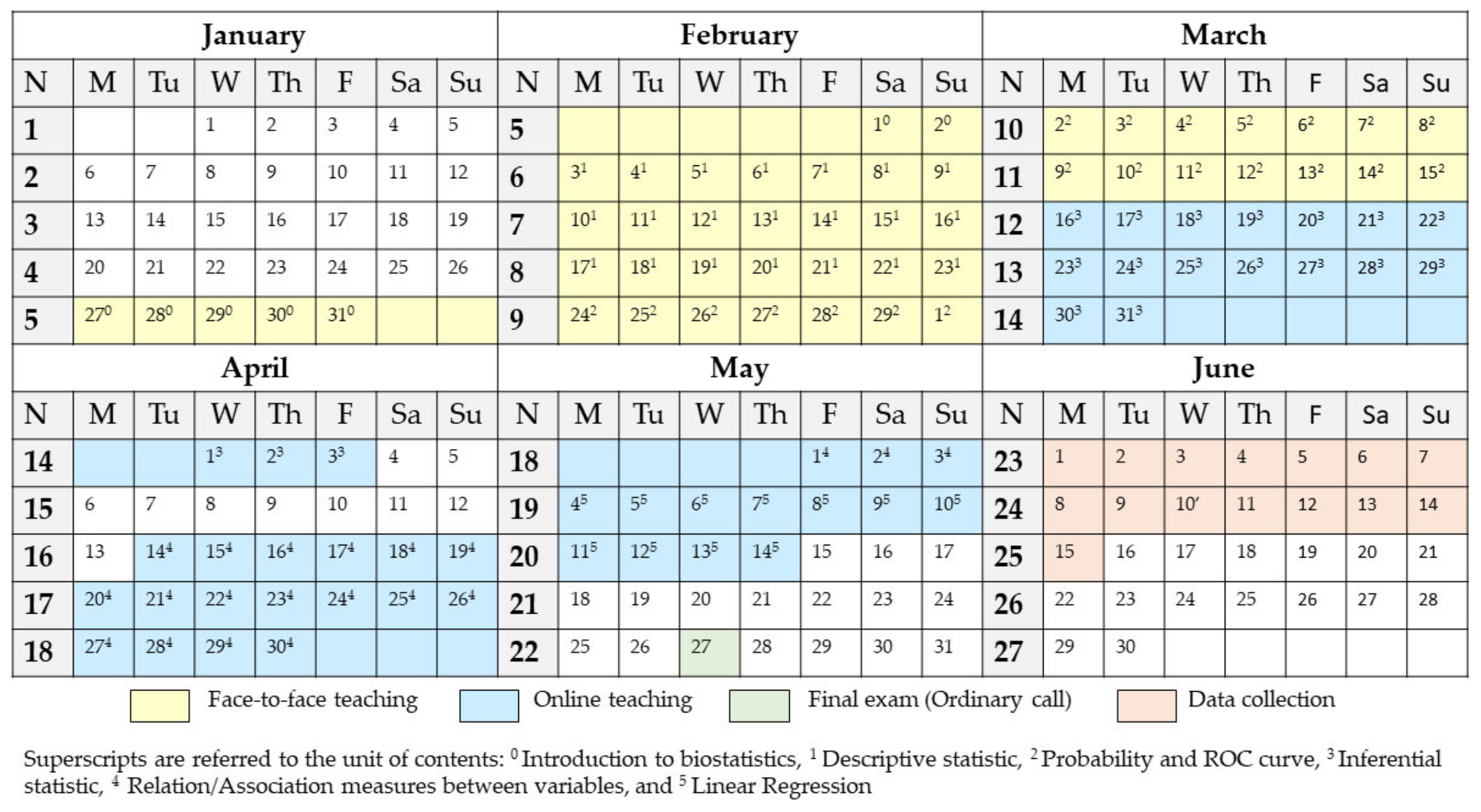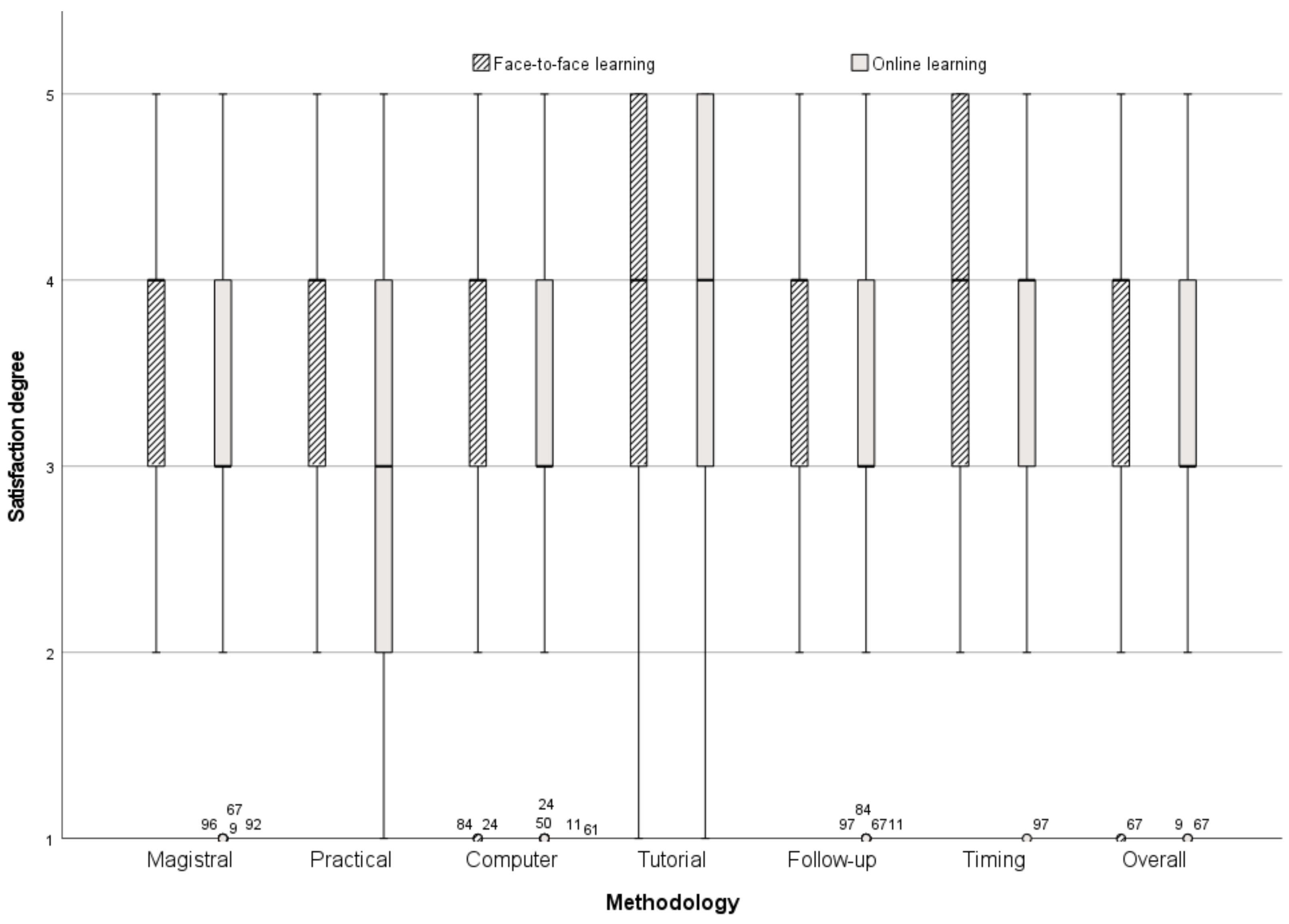Face-to-Face or Online Learning in Applied Statistics in Health Sciences? Failed Experiment or Opportunity after COVID-19?
Abstract
1. Introduction
1.1. Learning Difficulties
1.2. Literature Review
1.3. Objectives of the Study
2. Materials and Methods
2.1. Sampling and Instrumentation
2.2. Demograpich Features
2.3. Statistical Analysis
2.4. Description of the Learning Methodologies and Other Aspects of the Subject’s Assessment
2.4.1. Magistral Lessons
2.4.2. Practical Classes
2.4.3. Computer Classes
2.4.4. Tutorials
2.4.5. Other Aspects of the Subject’s Assessment
3. Results
3.1. Face-to-Face vs. E-Learning
3.2. Technological Difficulties Found in E-Learning
3.3. Psychological Difficulties Derived from COVID-19 in E-Learning
3.4. Online Evaluation
4. Discussion
Author Contributions
Funding
Institutional Review Board Statement
Informed Consent Statement
Data Availability Statement
Conflicts of Interest
References
- Ocaña-Riola, R. The Use of Statistics in Health Sciences: Situation Analysis and Perspective. Stat. Biosci. 2016, 8, 204–219. [Google Scholar] [CrossRef]
- National Library of Medicine. Available online: https://www.nlm.nih.gov (accessed on 7 November 2022).
- Resolución de 17 de Febrero de 2010, de la Universidad de Castilla-La Mancha, por la que se Publica el Plan de Estudios de Graduado en Enfermería. Boletín Of. Del Estado 2010, 55, 22288–22291, BOE-A-2010-3584. Available online: https://www.boe.es/boe/dias/2010/03/04/pdfs/BOE-A-2010-3584.pdf (accessed on 7 November 2022).
- Greenberg, G. Distance education technologies: Best practices for K-12 settings. IEEE Technol. Soc. Mag. 1998, 17, 36–40. [Google Scholar] [CrossRef]
- Aggarwal, A.K.; Bento, R. Web-based education. In Web-Based Learning and Teaching Technologies: Opportunities and Challenges; Aggarwal, A., Ed.; Idea Group: Hershey, PA, USA, 2000; pp. 2–16. [Google Scholar]
- Chen, P.S.D.; Lambert, A.D.; Guidry, K.R. Engaging online learners: The impact of Web-based learning technology on college student engagement. Comput. Educ. 2010, 54, 1222–1232. [Google Scholar] [CrossRef]
- Anderson, T. Towards a theory of online learning. Theory Pract. Online Learn. 2004, 2, 109–119. [Google Scholar]
- McCormick, N.B.; McCormick, J.W. Computer friends and foes: Content of undergraduates’ electronic mail. Comput. Hum. Behav. 1992, 8, 379–405. [Google Scholar] [CrossRef]
- Cucinotta, D.; Vanelli, M. WHO declares COVID-19 a Pandemic. Acta BioMed. Atenei Parm. 2020, 91, 157–160. [Google Scholar] [CrossRef]
- Real Decreto 463/2020, de 14 de Marzo, por el que se Declara el Estado de Alarma para la Gestión de la Situación de Crisis Sanitaria Ocasionada por el COVID-19. Boletín Of. Del Estado 2020, 67, 25390–25400, BOE-A-2020-3692. Available online: https://www.boe.es/eli/es/rd/2020/03/14/463/dof/spa/pdf (accessed on 7 November 2022).
- Gamage, K.A.; Gamage, A.; Dehideniya, S.C. Online and Hybrid Teaching and Learning: Enhance Effective Student Engagement and Experience. Educ. Sci. 2022, 12, 651. [Google Scholar] [CrossRef]
- Bassi, F. Students’ satisfaction in higher education: The role of practices, needs and beliefs of teachers. Qual. Assur. Educ. 2019, 27, 56–69. [Google Scholar] [CrossRef]
- Gámiz-Sánchez, V.; Gutiérrez-Santiuste, E.; Hinojosa-Pareja, E. Influence of professors on student satisfaction with e-portfolio use. J. Educ. Comput. Res. 2019, 57, 646–669. [Google Scholar] [CrossRef]
- Corham, J.; Kelley, D.H.; McCroskey, J.C. The affinity-seeking of classroom teachers: A second perspective. Commun. Q. 1989, 37, 16–26. [Google Scholar] [CrossRef]
- Frymier, A.B. The use of affinity-seeking in producing liking and learning in the classroom. J. Appl. Commun. Res. 1994, 22, 87–105. [Google Scholar] [CrossRef]
- Gaidelys, V.; Čiutienė, R.; Cibulskas, G.; Miliauskas, S.; Jukštaitė, J.; Dumčiuvienė, D. Assessing the Socio-Economic Consequences of Distance Learning during the COVID-19 Pandemic. Educ. Sci. 2022, 12, 685. [Google Scholar] [CrossRef]
- Bedoya, C.E.Y.; Popa, I.; Morandi, A.; Montomoli, C. Mental health during the COVID-19 quarantine in five countries. One Health Risk Manag. 2021, 2, 65–75. [Google Scholar] [CrossRef]
- Prati, G.; Mancini, A.D. The psychological impact of COVID-19 pandemic lockdowns: A review and meta-analysis of longitudinal studies and natural experiments. Psychol. Med. 2021, 51, 201–211. [Google Scholar] [CrossRef]
- Idowu, A.; Olawuyi, D.A.; Nwadioke, C.O. Impacts of covid-19 pandemic on the psychological wellbeing of students in a Nigerian university. JMSR 2020, 7, 798–806. [Google Scholar] [CrossRef]
- Espina-López, F.; Moreno-Sánchez, E.; Gago-Valiente, F.J.; Sáez-Padilla, J.; Salado-Navarro, V.; Merino-Godoy, M.D.L.Á. Psychological Discomfort in Nursing Degree Students as a Consequence of the COVID-19 Pandemic. J. Clin. Med. 2021, 10, 5467. [Google Scholar] [CrossRef]
- Zuyev, S.; Enelund, M. VLE: Virtual Learning Environment for Probability and Statistics. In Proceeding of 15th SEFI MWG SEMINAR AND 8th WORKSHOP GFC, Wismar, Germany, 20–23 June 2010. [Google Scholar]
- Murphy, T.; Goeser, P.T.; Williams, C. Analysis of Usage Statistics of MATLAB Marina-A Virtual Learning Environment. In Proceedings of the 2018 ASEE Southeast Section Annual Conference, Daytona Beach, FL, USA, 4–6 March 2018. [Google Scholar]
- López, A.J.; Pérez, R. Learning statistics in a shared virtual campus. Summarizing a five-year experience. Instr. Technol. Distance Learn. 2005, 2, 29–40. [Google Scholar]
- Lane, D.M. The Rice Virtual Lab in Statistics. Behav. Res. Methods Instrum. Comput. 1999, 31, 24–33. [Google Scholar] [CrossRef]
- Bulmer, M. Virtual worlds for teaching statistics. Int. J. Innov. Sci. Math. Educ. 2012, 11, 1–4. [Google Scholar]
- Baglin, J.; Bedford, A.; Bulmer, M. Students’ experiences and perceptions of using a virtual environment for project-based assessment in an online introductory statistics course. Technol. Innov. Stat. Educ. 2013, 7. [Google Scholar] [CrossRef]
- Mittag, H.J. Virtual learning environments for statistics education and applications for official statistics. In Proceedings of the Korean Statistical Society Conference, November 2004; The Korean Statistical Society: Seoul, Korea, 2004; pp. 307–312. [Google Scholar]
- Hernández, M.C.V.; Alastrué, J.A.G.; Arsenal, R.M.; Pérez, J.M.P. The impact of COVID-19 on teaching in statistics and operations research in higher education. BEIO Boletín Estadística Investig. Oper. 2020, 36, 173–200. [Google Scholar]
- Ramos-Pla, A.; Reese, L.; Arce, C.; Balladares, J.; Fiallos, B. Teaching Online: Lessons Learned about Methodological Strategies in Postgraduate Studies. Educ. Sci. 2022, 12, 688. [Google Scholar] [CrossRef]
- Ponterotto, J.G.; Ruckdeschel, D.E. An overview of coefficient alpha and a reliability matrix for estimating adequacy of internal consistency coefficients with psychological research measures. Percept. Mot. Ski. 2007, 105, 997–1014. [Google Scholar] [CrossRef] [PubMed]
- Wojtowicz, J. Virtual Design Studio; Hong Kong University Press: Hong Kong, China, 1995; Available online: http://www.jstor.org/stable/j.ctt2jc401 (accessed on 7 November 2022).
- Moodle. Available online: https://moodle.org/?lang=es (accessed on 7 November 2022).
- Microsoft Teams. Available online: https://www.microsoft.com/es-es/microsoft-teams/log-in (accessed on 7 November 2022).
- Bryson, J.R.; Andres, L. COVID-19 and rapid adoption and improvisation of online teaching: Curating resources for extensive versus intensive online learning experiences. J. Geogr. High. Educ. 2020, 44, 608–623. [Google Scholar] [CrossRef]
- Tomczak, M.; Tomczak, E. The need to report effect size estimates revisited. An overview of some recommended measures of effect size. Trends Sport Sci. 2014, 1, 19–25. [Google Scholar]
- Besser, A.; Flett, G.L.; Zeigler-Hill, V. Adaptability to a sudden transition to online learning during the COVID-19 pandemic: Understanding the challenges for students. Scholarsh. Teach. Learn. Psychol. 2022, 8, 85–105. [Google Scholar] [CrossRef]
- Horesh, D.; Brown, A.D. Traumatic stress in the age of COVID-19: A call to close critical gaps and adapt to new realities. Psychol. Trauma: Theory Res. Pract. Policy 2020, 12, 331–335. [Google Scholar] [CrossRef]


| Block 1. Socio-Demographic Features |
|
|
|
|
| Block 2. Evaluation of learning methodologies and assessment of the subject |
|
| Block 3. Learning difficulties due to ICTs |
|
|
|
| Block 4. Psychological impact of the COVID-19 |
|
| Block 5. Assessment of the online evaluation |
|
| Variables | Statistics |
|---|---|
| Age Mean (SD) | 19.5 (±2.7) |
| Gender | |
| Male | 26 (20.3%) |
| Female | 102 (79.3%) |
| Grade | |
| 1 | 116 (90.6%) |
| 2 | 8 (6.3%) |
| 3 | 2 (1.6%) |
| 4 | 2 (1.6%) |
| Sufficient technological resources | |
| Yes | 97 (75.8%) |
| No | 31 (24.2%) |
| Sufficient internet connection | |
| Yes | 95 (74.2%) |
| No | 33 (25.8%) |
| Type of internet connection | |
| Optical fiber | 79 (61.7%) |
| ADSL | 42 (32.8%) |
| Mobile connection | 7 (5.5%) |
| Psychological affectation | |
| Nothing | 11 (8.6%) |
| Something | 88 (68.8%) |
| Severe | 29 (22.7%) |
| Residence before COVID-19 | |
| University residence | 23 (18%) |
| Shared apartment | 58 (45.3%) |
| Alone, in an apartment | 2 (1.6%) |
| Parents’ residence | 43 (33.6%) |
| Others | 2 (1.6%) |
| Residence during COVID-19 | |
| University residence | 0 (0%) |
| Shared apartment | 4 (3.1%) |
| Alone, in an apartment | 4 (3.1%) |
| Parents’ residence | 115 (89.8%) |
| Others | 5 (3.9%) |
| Face-to-Face Learning | Online Learning | ||||
|---|---|---|---|---|---|
| Learning Methodologies and Valuation | Mean ( SD 1) | Range | Mean ( SD) | Range | p Value |
| Master classes/theoretical ** 3 | 3.19 (0.72) | 2–5 | 3.21 (1.05) | 1–5 | <0.01 |
| Practical classes/study-case resolution * 2 | 3.46 (0.83) | 2–5 | 3.16 (1.20) | 1–5 | 0.03 |
| Computer classes/SPSS software | 3.63 (0.96) | 1–5 | 3.36 (1.20) | 1–5 | 0.08 |
| Tutorials | 4.04 (0.97) | 1–5 | 3.85 (1.14) | 1–5 | 0.13 |
| Follow-up ** 3 | 3.74 (0.92) | 2–5 | 3.40 () | 1–5 | <0.01 |
| Timing ** 3 | 3.98 (0.86) | 2–5 | 3.63 (1.03) | 1–5 | <0.01 |
| Overall ** 3 | 3.72 (0.77) | 1–5 | 3.42 (0.99) | 1–5 | <0.01 |
| Type of Connection/ Sufficient Internet Connection | Mobile Connection | ADSL | Optical Fiber | Total |
|---|---|---|---|---|
| No | 3 | 11 | 11 | 25 |
| Yes | 4 | 26 | 57 | 87 |
| Total | 7 | 37 | 68 | 112 |
Publisher’s Note: MDPI stays neutral with regard to jurisdictional claims in published maps and institutional affiliations. |
© 2022 by the authors. Licensee MDPI, Basel, Switzerland. This article is an open access article distributed under the terms and conditions of the Creative Commons Attribution (CC BY) license (https://creativecommons.org/licenses/by/4.0/).
Share and Cite
García-Camacha Gutiérrez, I.; Pozuelo-Campos, S.; García-Camacha Gutiérrez, A.; Jiménez-Alcázar, A. Face-to-Face or Online Learning in Applied Statistics in Health Sciences? Failed Experiment or Opportunity after COVID-19? Educ. Sci. 2022, 12, 922. https://doi.org/10.3390/educsci12120922
García-Camacha Gutiérrez I, Pozuelo-Campos S, García-Camacha Gutiérrez A, Jiménez-Alcázar A. Face-to-Face or Online Learning in Applied Statistics in Health Sciences? Failed Experiment or Opportunity after COVID-19? Education Sciences. 2022; 12(12):922. https://doi.org/10.3390/educsci12120922
Chicago/Turabian StyleGarcía-Camacha Gutiérrez, Irene, Sergio Pozuelo-Campos, Aurora García-Camacha Gutiérrez, and Alfonso Jiménez-Alcázar. 2022. "Face-to-Face or Online Learning in Applied Statistics in Health Sciences? Failed Experiment or Opportunity after COVID-19?" Education Sciences 12, no. 12: 922. https://doi.org/10.3390/educsci12120922
APA StyleGarcía-Camacha Gutiérrez, I., Pozuelo-Campos, S., García-Camacha Gutiérrez, A., & Jiménez-Alcázar, A. (2022). Face-to-Face or Online Learning in Applied Statistics in Health Sciences? Failed Experiment or Opportunity after COVID-19? Education Sciences, 12(12), 922. https://doi.org/10.3390/educsci12120922







